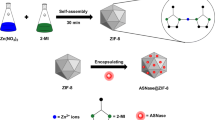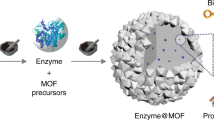Abstract
In situ encapsulation is an effective way to synthesize enzyme@metal-organic framework biocatalysts; however, it is limited by the conditions of metal-organic framework synthesis and its acid-base stability. Herein, a biocatalytic platform with improved acid-base stability was constructed via a one-pot method using bismuth-ellagic acid as the carrier. Bismuth-ellagic acid is a green phenol-based metal-organic framework whose organic precursor is extracted from natural plants. After encapsulation, the stability, especially the acid-base stability, of amyloglucosidases@bismuth-ellagic acid was enhanced, which remained stable over a wide pH range (2–12) and achieved multiple recycling. By selecting a suitable buffer, bismuth-ellagic acid can encapsulate different types of enzymes and enable interactions between the encapsulated enzymes and cofactors, as well as between multiple enzymes. The green precursor, simple and convenient preparation process provided a versatile strategy for enzymes encapsulation.

Similar content being viewed by others
References
Wu S, Snajdrova R, Moore J C, Baldenius K, Bornscheuer U T. Biocatalysis: enzymatic synthesis for industrial applications. Angewandte Chemie International Edition, 2021, 60(1): 88–119
Rodrigues R C, Berenguer-Murcia A, Carballares D, Morellon-Sterling R, Fernandez-Lafuente R. Stabilization of enzymes via immobilization: multipoint covalent attachment and other stabilization strategies. Biotechnology Advances, 2021, 52: 107821
Wiltschi B, Cernava T, Dennig A, Galindo Casas M, Geier M, Gruber S, Haberbauer M, Heidinger P, Herrero Acero E, Kratzer R, Luley-Goedl C, Müller C A, Pitzer J, Ribitsch D, Sauer M, Schmölzer K, Schnitzhofer W, Sensen C W, Soh J, Steiner K, Winkler C K, Winkler M, Wriessnegger T. Enzymes revolutionize the bioproduction of value-added compounds: from enzyme discovery to special applications. Biotechnology Advances, 2020, 40: 107520
Jemli S, Ayadi-Zouari D, Hlima H B, Bejar S. Biocatalysts: application and engineering for industrial purposes. Critical Reviews in Biotechnology, 2016, 36(2): 246–258
Bell E L, Finnigan W, France S P, Green A P, Hayes M A, Hepworth L J, Lovelock S L, Niikura H, Osuna S, Romero E, Ryan K S, Turner N J, Flitsch S L. Biocatalysis. Nature Reviews Methods Primers, 2021, 1(1): 46
Sheldon R A, Pelt S V. Enzyme immobilisation in biocatalysis: why, what and how. Chemical Society Reviews, 2013, 42(15): 6223–6235
Finnigan W, Hepworth L J, Flitsch S L, Turner N J. RetroBioCat as a computer-aided synthesis planning tool for biocatalytic reactions and cascades. Nature Catalysis, 2021, 4(2): 98–104
Santos A G, da Rocha G O, de Andrade J B. Occurrence of the potent mutagens 2-nitrobenzanthrone and 3-nitrobenzanthrone in fine airborne particles. Scientific Reports, 2019, 9(1): 1–13
Garcia-Galan C, Berenguer-Murcia A, Fernandez-Lafuente R, Rodrigues R C. Potential of different enzyme immobilization strategies to improve enzyme performance. Advanced Synthesis & Catalysis, 2011, 353(16): 2885–2904
Sheldon R A, Basso A, Brady D. New frontiers in enzyme immobilisation: robust biocatalysts for a circular bio-based economy. Chemical Society Reviews, 2021, 50(10): 5850–5862
Wu X, Hou M, Ge J. Meta-organic frameworks and inorganic nanoflowers: a type of emerging inorganic crystal nanocarrier for enzyme immobilization. Catalysis Science & Technology, 2015, 5(12): 5077–5085
Cui J, Ren S, Sun B, Jia S. Optimization protocols and improved strategies for metal-organic frameworks for immobilizing enzymes: current development and future challenges. Coordination Chemistry Reviews, 2018, 370: 22–41
Liu J, Liang J, Xue J, Liang K. Metal-organic frameworks as a versatile materials platform for unlocking new potentials in biocatalysis. Small, 2021, 17(32): e2100300
Wang X, Lan P, Ma S. Metal-organic frameworks for enzyme immobilization: beyond host matrix materials. ACS Central Science, 2020, 6(9): 1497–1506
Gkaniatsou E, Sicard C, Ricoux R, Mahy J P, Steunou N, Serre C. Metal-organic frameworks: a novel host platform for enzymatic catalysis and detection. Materials Horizons, 2017, 4(1): 55–63
Liang K, Ricco R, Doherty C M, Styles M J, Bell S, Kirby N, Mudie S, Haylock D, Hill A J, Doonan C J, Falcaro P. Biomimetic mineralization of metal-organic frameworks as protective coatings for biomacromolecules. Nature Communications, 2015, 6(1): 7240
Huang W, Zhang W, Gan Y, Yang J, Zhang S. Laccase immobilization with metal-organic frameworks: current status, remaining challenges and future perspectives. Critical Reviews in Environmental Science and Technology, 2020, 52, 7: 1282–1324
Tong L, Huang S, Shen Y, Liu S, Ma X, Zhu F, Chen G, Ouyang G. Atomically unveiling the structure-activity relationship of biomacromolecule-metal-organic frameworks symbiotic crystal. Nature Communications, 2022, 13(1): 951
Huang S, Chen G, Ouyang G. Confining enzymes in porous organic frameworks: from synthetic strategy and characterization to healthcare applications. Chemical Society Reviews, 2022, 51(15): 6824–6863
Li Z, Wang L, Qin L, Lai C, Wang Z, Zhou M, Xiao L, Liu S, Zhang M. Recent advances in the application of water-stable metal-organic frameworks: adsorption and photocatalytic reduction of heavy metal in water. Chemosphere, 2021, 285: 131432
He T, Kong X J, Li J R. Chemically stable metal-organic frameworks: rational construction and application expansion. Accounts of Chemical Research, 2021, 54(15): 3083–3094
Guo Y, Sun Q, Wu F, Dai Y, Chen X. Polyphenol-containing nanoparticles: synthesis, properties, and therapeutic delivery. Advanced Materials, 2021, 33(22): e2007356
Lin Z, Zhou J, Cortez-Jugo C, Han Y, Ma Y, Pan S, Hanssen E, Richardson J J, Caruso F. Ordered mesoporous metal-phenolic network particles. Journal of the American Chemical Society, 2020, 142(1): 335–341
Ejima H, Richardson J J, Caruso F. Metal-phenolic networks as a versatile platform to engineer nanomaterials and biointerfaces. Nano Today, 2017, 12: 136–148
Chen E, Qiu M, Zhang Y, Zhu Y, Liu L, Sun Y, Bu X, Zhang J, Lin Q. Acid and base resistant zirconium polyphenolate-metalloporphyrin scaffolds for efficient CO2 photoreduction. Advanced Materials, 2018, 30(2): 1704388
Ismail M, Bustam M A, Yeong Y F. Gallate-based metal-organic frameworks, a new family of hybrid materials and their applications: a review. Crystals, 2020, 10(11): 1006
Chiong J A, Zhu J, Bailey J B, Kalaj M, Subramanian R H, Xu W, Cohen S M, Tezcan F A. An exceptionally stable metal-organic framework constructed from chelate-based metal-organic polyhedra. Journal of the American Chemical Society, 2020, 142(15): 6907–6912
Grape E S, Flores J G, Hidalgo T, Martinez-Ahumada E, Gutierrez-Alejandre A, Hautier A, Williams D R, O’Keeffe M, Ohrstrom L, Willhammar T, Horcajada P, Ibarra I A, Inge A K. A robust and biocompatible bismuth ellagate MOF synthesized under green ambient conditions. Journal of the American Chemical Society, 2020, 142(39): 16795–16804
Miller G N. Use of dinitrosaIicyIic acid reagent for determination of reducing sugar. Analytical Chemistry, 1959, 81(3): 426–428
Wang Z, Zeng Z, Wang H, Zeng G, Xu P, Xiao R, Huang D, Chen S, He Y, Zhou C, Cheng M, Qin H. Bismuth-based metal-organic frameworks and their derivatives: opportunities and challenges. Coordination Chemistry Reviews, 2021, 439: 2139052
Yang N, Sun H. Biocoordination chemistry of bismuth: recent advances. Coordination Chemistry Reviews, 2007, 251(17–20): 2354–2366
Wang L, Wang Y, He R, Zhuang A, Wang X, Zeng J, Hou J. A new nanobiocatalytic system based on allosteric effect with dramatically enhanced enzymatic performance. Journal of the American Chemical Society, 2013, 135(4): 1272–1275
Jiang Z, Chen Y, Xing M, Ji P, Feng W. Fabrication of a fibrous metal-organic framework and simultaneous immobilization of enzymes. ACS Omega, 2020, 5(36): 22708–22718
Good N E, Winget G D, Winter W, Connolly T N, Izawa S, Singh R M. Hydrogen ion buffers for biological research. Biochemistry, 1966, 5(2): 467–477
Colwell K A, Jackson M N, Torres-Gavosto R M, Jawahery S, Vlaisavljevich B, Falkowski J M, Smit B, Weston S C, Long J R. Buffered coordination modulation as a means of controlling crystal morphology and molecular diffusion in an anisotropic metal-organic framework. Journal of the American Chemical Society, 2021, 143(13): 5044–5052
Fogarty W M, Benson C P. Purification and properties of a thermophilic amyloglucosidase from Aspergillus nige. European Journal of Applied Microbiology and Biotechnology, 1983, 18(5): 271–278
Pan Y, Li Q, Li H, Farmakes J, Ugrinov A, Zhu X, Lai Z, Chen B, Yang Z. A general Ca-MOM platform with enhanced acid-base stability for enzyme biocatalysis. Chem Catalysis, 2021, 1(1): 146–161
Pan Y, Li H, Farmakes J, Xiao F, Chen B, Ma S, Yang Z. How do enzymes orient when trapped on metal-organic framework (MOF) surfaces? Journal of the American Chemical Society, 2018, 140(47): 16032–16036
Owusu R K, Makhzoum A, Knapp J S. Heat inactivation of lipase from psychrotrophic Pseudomonas fluorescens P38: activation parameters and enzyme stability at low or ultra-high temperatures. Food Chemistry, 1992, 44(4): 261–268
Pietricola G, Ottone C, Fino D, Tommasi T. Enzymatic reduction of CO2 to formic acid using FDH immobilized on natural zeolite. Journal of CO2 Utilization, 2020, 42: 101343
Tang Y, Li W, Muhammad Y, Jiang S, Huang M, Zhang H, Zhao Z, Zhao Z. Fabrication of hollow covalent-organic framework microspheres via emulsion-interfacial strategy to enhance laccase immobilization for tetracycline degradation. Chemical Engineering Journal, 2021, 421: 129743
Patil P D, Yadav G D. Rapid in situ encapsulation of laccase into metal-organic framework support (ZIF-8) under biocompatible conditions. ChemistrySelect, 2018, 3(17): 4669–4675
de Castro R J S, Ohara A, Nishide T G, Albernaz J R M, Soares M H, Sato H H. A new approach for proteases production by Aspergillus niger based on the kinetic and thermodynamic parameters of the enzymes obtained. Biocatalysis and Agricultural Biotechnology, 2015, 4(2): 199–207
Chen G, Kou X, Huang S, Tong L, Shen Y, Zhu W, Zhu F, Ouyang G. Modulating the biofunctionality of metal-organic-framework-encapsulated enzymes through controllable embedding patterns. Angewandte Chemie International Edition, 2020, 59(7): 2867–2874
Maddigan N K, Tarzia A, Huang D M, Sumby C J, Bell S G, Falcaro P, Doonan C J. Protein surface functionalisation as a general strategy for facilitating biomimetic mineralisation of ZIF-8. Chemical Science, 2018, 9(18): 4217–4123
Hsu P H, Chang C C, Wang T H, Lam P K, Wei M Y, Chen C T, Chen C Y, Chou L Y, Shieh F K. Rapid fabrication of biocomposites by encapsulating enzymes into Zn-MOF-74 via a mild water-based approach. ACS Applied Materials & Interfaces, 2021, 13(44): 52014–52022
Acknowledgements
This work was financially supported by the National Natural Science Foundation of China (Grant Nos. 22178083, 22078081 and 21878068), the Natural Science Foundation of Tianjin China (Grant No. 20JCYBJC00530), the Hebei Key Research and Development Project (Grant No. 20372802D), Open Funding Project of the State Key Laboratory of Biocatalysis and Enzyme Engineering (Grant No. SKLBEE2020011), Science Technology Research Project of Higher Education of Hebei Province (Grant No. QN2021045) and Tianjin Enterprise Science and Technology Commissioner Project (Grant No. 21YDTPJC00810).
Author information
Authors and Affiliations
Corresponding authors
Electronic Supplementary Material
Rights and permissions
About this article
Cite this article
Xu, J., Liu, G., He, Y. et al. Enzyme@bismuth-ellagic acid: a versatile platform for enzyme immobilization with enhanced acid-base stability. Front. Chem. Sci. Eng. 17, 784–794 (2023). https://doi.org/10.1007/s11705-022-2278-4
Received:
Accepted:
Published:
Issue Date:
DOI: https://doi.org/10.1007/s11705-022-2278-4




